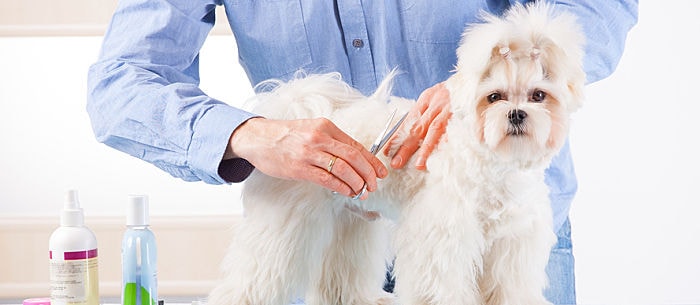You dread the day your kids come home with lice, but did you know your pooch can catch lice, too? Dogs contract this pest from other dogs, just as kids contract lice from infected kids.
Here’s what you need to know to help your furry friend:
What Is Dog Lice?
“A louse is a wingless, insect parasite that can be seen with the naked eye, appearing almost like brown, slow-moving dandruff. They spend their entire 21-day life cycle on the dog, as they can only live for a few hours off the pet,” says Dr. Karen Stuedemann, a veterinarian and medical director at Tails Humane Society.
“There are two types of lice that infest dogs, chewing (feeds on skin debris) and sucking (feeds on blood).” Similarly, a human louse is small, wingless parasite that nests in the hair and thrives off small amounts of blood from the scalp. Human nits range in color from yellow to brown and, as with dog lice, once hatched remain “glued” to the hair, making them visible and treatable.
For canines and kids, scratching — sometimes until the skin is red and raw — is a telltale sign. Other signs for dogs include “hair loss, itchiness and a rough coat,” says Dr. Stuedemann.
What Causes It?
Canines contract lice in the same way as humans. When dogs convene in common areas, they can pass parasites to each other.
Luckily, dogs and children won’t pass the lice back and forth to each other, says Dr. Stuedemann, adding, “Lice are very host-specific, so they will not live on other species. Dogs pick up lice from other dogs and are less likely to pick them up from bedding or grooming equipment.”
And the chance of your dog contracting lice is slim, while it’s almost a rite of passage for kids. “Lice on dogs is uncommon in the United States and is seen more on animals in crowded or filthy conditions,” Dr. Stuedemann says.
In a case treated by Kendra Marten, the owner and manager of Bed and Biscuit, a pet boarding and grooming service, the lice weren’t immediately visible. “I have only seen one dog with lice,” she explains. “I had a client bring in a toy poodle mix they found as a stray while on vacation. The lice weren’t noticeable until I had shaved him down to remove his matted hair.”
How Can You Treat It?
Dr. Stuedemann says you shouldn’t have trouble spotting the pests. “The nits — lice eggs — are readily seen and first appear like white flakes, but are actually glued to the shafts of hair,” she says. She urges owners and caretakers to do a thorough search of the dog’s body to identify all affected areas, similar to a spot check on your child’s scalp. “The most likely areas to spot lice are around the ears, neck, shoulders and anus.” A fine-tooth comb works perfectly for this job.
Keeping your dog groomed regularly helps keep infestations away, unlike in humans where it doesn’t matter if you’re clean or not. Marten agrees: “Dog lice are a rare occurrence at my grooming salon. This is because the majority of my clients bring their dogs in on a fairly regular basis to be bathed and groomed. All of my drying cages, tools and brushes are disinfected between clients to prevent the spread of parasites and germs.”
In the same way you discourage kids to not share hats, combs, brushes and towels, don’t share dog grooming tools either. Your dog might unfortunately get lonely while the lice start to fade away. “Owners [should] keep their dog away from other dogs until the lice infestation has been eliminated,” emphasizes Marten.
Stuedemann recommends contacting a professional before performing an at-home treatment, such as cutting the dog’s fur and bathing. And, she urges, don’t use a treatment meant for humans, such as medicated shampoo. “Human lice infestations are typically cleared using topical treatments that work only on the surface of the affected area,” she says, “whereas Frontline and Revolution [pet medicines] are absorbed in one spot on the back of the neck to create a systemic, whole-body effect.”
Happily, with a safe treatment plan, including a thorough cleaning of all infested bedding and tools, your pooch should be free of itches and lice in a few weeks!
Want to keep your pup clean? Check out these homemade dog shampoo recipes!
Christine O’Brien is a writer and a mom to a preschooler and two cranky cats. Follow her on Twitter.






